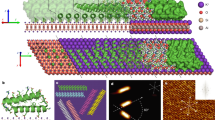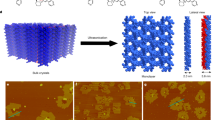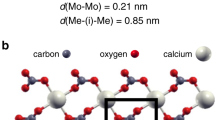Abstract
MOLECULAR recognition at inorganic surfaces has the potential to provide control over crystal growth processes. For organic surfaces, molecules that influence crystallization1–3 can be derived by rational modification of host molecules to give the stereochemistry required by the surface structure. This approach is of little use for inorganic systems, however, because the relatively simple stereochemistries of the surfaces and ions concerned allow little scope for similar manipulation. Previous work4–6, therefore, has been essentially phenomenological. Here we show that a detailed understanding of recognition processes at inorganic surfaces can nevertheless lead to the rational design of surface-active molecules. We have used crystal morphological characteristics to deduce the nature of the surface binding sites of diphosphonates on barium sulphate crystals, and have thereby been able to design new surface-active molecules with improved efficacy.
This is a preview of subscription content, access via your institution
Access options
Subscribe to this journal
Receive 51 print issues and online access
$199.00 per year
only $3.90 per issue
Buy this article
- Purchase on Springer Link
- Instant access to full article PDF
Prices may be subject to local taxes which are calculated during checkout
Similar content being viewed by others
References
Berkovitch-Yellin, Z., Addadi, L., Idelson, M., Lahav, M. & Leiserowitz, L. Angew. Chem. Suppl. 1336–1345 (1982).
Staab, E., Addadi, L., Lieserowitz, L. & Lahav, M. Adv. Mater. 2, 40–43 (1990).
Davey, R. J., Polywka, L. A. & Maginn, S. M. in Advances in Industrial Crystallisation (eds Garside, J. et al.) 150–165 (Butterworth-Heinemann, Oxford, 1991).
Whetstone, J. Nature 168, 663–664 (1951).
Weijnen, M. P. C. & van Rosmalen, G. M. in Industrial Crystallisation 84 (eds Jancic, S. J. & de Jong, E. J.) 61–66 (Elsevier, Amsterdam, 1984).
Mann, S., Didymus, J., Sanderson, N. P., Heywood, B. & Aso-Samper, E. J. J. chem. Soc. Faraday Trans. 86, 1873–1880 (1990).
Wilcock, J. R., Perry, C. C., Williams, R. J. P. & Brook, A. J. Proc. R. Soc. Lond. B238, 203–222 (1989).
Black, S. N. et al. J. chem. Soc. Faraday Trans. (in the press).
Stewart, J. J. P. MOPAC Version 5.0, QCPE No. 455 (Department of Chemistry, Indiana University, 1989).
Moedritzer, K. & Irani, R. J. org. Chem. 31, 1603–1607 (1966).
Author information
Authors and Affiliations
Rights and permissions
About this article
Cite this article
Davey, R., Black, S., Bromley, L. et al. Molecular design based on recognition at inorganic surfaces. Nature 353, 549–550 (1991). https://doi.org/10.1038/353549a0
Received:
Accepted:
Issue Date:
DOI: https://doi.org/10.1038/353549a0
This article is cited by
-
Quantum chemical modelling case studies relevant to metal oxide dissolution and catalysis
Ionics (2001)
-
Simulating the structures of crystals and their surfaces
Topics in Catalysis (1996)
Comments
By submitting a comment you agree to abide by our Terms and Community Guidelines. If you find something abusive or that does not comply with our terms or guidelines please flag it as inappropriate.



